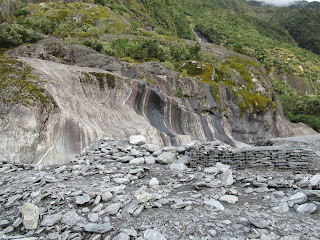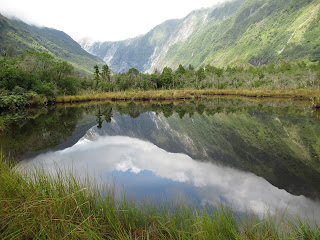I am simultaneously finishing a travel blog about the fantastic 4.5 month long trip Steven and I took last fall to Armenia, Georgia, Azerbaijan, much of Central Asia and then the final six weeks in Spain and Portugal. If you're interested in checking that exciting adventure out, here's the link:
www.bergersadventures6.blogspot.com
My friend Diane and I left the town of Franz Joseph to drive toward the Franz Joseph Glacier Valley where we'd planned to go on several hikes. It was the first time I remember seeing red-colored rocks like these in the gravel bed.
In 1908, the glacier ended where I stood to take this picture. Glaciers, as you likely know, are simply rivers of ice. High in these Southern Alps, snow builds up until it compacts into ice under its own weight. The ice then flows downhill, carrying debris with it and carving u-shaped valleys. Though Franz Joseph Glacier seemed motionless, it could shift up to five meters a day! The ice can pick up and carry rocks for several kilometers. As they retreat, glaciers leave debris behind in mounds called moraines.
A sign indicated the average global temperature in 1908 was 13.57 degrees Celsius but it had risen in 2016 to 14.87 degrees Celsius.
Helicopters were the only safe way to get people onto the glacier itself for guided walks. But Diane and I were content to hike toward the viewpoint which was the last spot for hikers not actually on the glacier itself. As this hike gets mobbed in the summertime, tourists were advised to then visit the glacier before 8 in the morning or after 6 in the evening.
The Waiho River was gray because of the 'rock flour' or literally rocks that had been ground up by the forces of nature.
Eventually, the debris-covered ice separates from the rest of the glacier and can be left behind in the valley. That was how Franz Joseph Glacier keeps shrinking. Even if global warming stopped today, glaciers would continue to retreat for at least a few more years before stabilizing. The global average temperature in 2009 was 14.59 degrees Celsius but it rose to 14.87 degrees Celsius in 2016.
Diane and I kept passing, and being passed by, this couple from Arizona on the trail. Fortunately, there were far fewer people on this stretch of the track which made it so much more pleasant.
Eighteen thousand years ago, Franz Joseph Glacier extended to the sea. Today the terminal face was 19 kilometers from the shore because of a warming climate. Even within the short time since the first Europeans came to New Zealand, the glacier had shrunk considerably. An uncertain future faced the glacier as more rain and less snow was the forecast for the Southern Alps. Increasing global temperatures are expected to cause New Zealand's glaciers to continue to shrink for the foreseeable future.
We overheard a guide say the glacier moves like a river but at a much slower rate of speed. Its main ice field moves about twenty feet a day. Unlike most glaciers, this one has been advancing and retreating seven times in the last hundred years due to El Nino. He added that Franz Joseph has lost three thousand feet in just the last eleven years because of the La Nina part of the cycle - a number that seemed truly mammoth. It was one thousand feet deep at its thickest part. The steepest part is what we were looking at.
After completing the Glacier Valley Hike, we were still eager to see more of the glacier so did the short Sentinel Rock Walk that also took us through another rainforest, naturally!
We had been in the park for several hours and never once did we see a garbage can, even near the picnic areas, as the park authorities and people in general in New Zealand, it seemed, adhered to the 'pack it in, pack it out philosophy.'
Steven and I have been very fortunate in seeing some spectacular reflections on our many travels but none of them came close to what Diane and I saw here at Peter's Pool. It was without a doubt the most gorgeous reflection I'd seen. I just hope these photos can do it justice. It was hard to know what was up and what was down because of the almost perfect mirror image.
Peter's Pool was a kettle lake formed by a huge block of ice left behind during the glacier's withdrawal. When this ice melted, it was contained in a depression - known as a kettle hole - among the mounds of rock debris deposited by the receding glacier.
Back in the town of Franz Joseph, we stopped for a few minutes at Our Lady of the Alps Catholic Church.
Rarely have I seen such a hard-hitting message from a parish priest as this one from the church's Fr. Mike imploring his parishioners to get children vaccinated and not pay attention to "some article on the internet to support some weird theory (that) doesn't make it true." I recommend you click on the photo so you can read it more easily as it's so powerful and especially timely now with the measles outbreak here in the US.
www.bergersadventures6.blogspot.com
My friend Diane and I left the town of Franz Joseph to drive toward the Franz Joseph Glacier Valley where we'd planned to go on several hikes. It was the first time I remember seeing red-colored rocks like these in the gravel bed.
Diane and I remarked that neither of us had come across speed bumps like these before. These ones really forced drivers to slow down!
This was our first view of the Southern Alps that morning. They were among the fastest growing mountains in the world, rising 10-20 millimeters per year. In the past few million years, they have risen more than 20 kilometers - over six times higher than they currently stand.
A little further on was our fist sight of the magnificent Franz Joseph Glacier we'd come to see and hike on. The glacier was named after European explorer Julius von Haast in 1865 after the then Emperor of Austria-Hungary. The picture looks pretty drab because it was very overcast and drizzly then.
It was strange seeing a rainforest in the middle of the Southern Alps on New Zealand's South Island! We probably shouldn't have been surprised at the sight because it seemed there were rainforests all over the country.
The Waiho River was gray because of the 'rock flour' or literally rocks that had been ground up by the forces of nature.
Seeing these waterfalls stream over the cliffs was a lovely sight.
Even though we were there in the early fall, there were still plenty of people on the track, so many, in fact, that we normally had to walk single file and keep to the left.
The Glacier Valley walk was a hike up the valley floor to a viewpoint close to the glacier face. The walk was over exposed, rough ground and involved crossing dry riverbeds when we were there en route to the viewpoint. Glacier visits have had to change because this landscape was on the move every day as the glacier retreated.
We stopped at one spot so Diane could built a rock cairn in memory of her husband, Ron, who always liked building them when they hiked.
We read a sign that indicated as the human population increases, we consume more resources and emit more greenhouse gases like carbon dioxide into the atmosphere. Greenhouse gases trap heat from the sun, insulating the planet like a huge blanket. As global temperatures rise, glaciers all over the world melt faster. Franz Joseph Glacier has retreated several kilometers over the past 150 years, and will continue to lose ice as the climate warms.
It was disturbing to see how much the glacier had retreated in my own lifetime and to see first-hand the effects of global warming. How I wished that climate change naysayers could come here to Franz Joseph Glacier and witness, as we just had, the effects of global warming on this relatively small part of the world
The rocks, which had been ground down by water and ice, had been collected to divert the runoff.
There were so few flowers along the trail, these looked especially attractive.
The terrain changed very quickly all of a sudden. Before this, we had seen the powerful force of water. In 2009, the glacier ended here at the gravel path. As glaciers thawed, dirt and rocks covered the terminus or end. The debris insulates and preserves the ice at the terminus, but the cleaner ice higher up keeps melting.
Diane and I kept passing, and being passed by, this couple from Arizona on the trail. Fortunately, there were far fewer people on this stretch of the track which made it so much more pleasant.
This was as far as anyone could hike on the trail. We were lucky that the viewpoint hadn't changed due to flooding and rock fall hazards. It would be fascinating but likely sad to return to this spot in ten years or so to see how far the glacier had retreated by then. I wonder how much farther up the valley future generations will have to walk to visit the glacier.
We did the Peter's Pool hike next which gave us a striking panoramic view of the glacier and the mountains surrounding it.
Peter's Pool was named for a nine-year-old boy who camped by its edges in 1894. The pool was one of the most serene natural sights I can recall at least, that was, until our peace was marred by the sound of a helicopter presumably taking hikers to or from the glacier.
I think we got our best view of the glacier from the parking lot when the clouds, which had dogged us most of the day, cleared. Our hike along the Glacier Valley and our views of Peter's Pool count among my top highlights of our entire trip to New Zealand.
Back in the town of Franz Joseph, we stopped for a few minutes at Our Lady of the Alps Catholic Church.
We drove onward to nearby Lake Mapourika Recreation Area which was as pretty as could be. I'd read that the sunsets on the lake were supposed to be gorgeous but Diane and I were too tired that night to return to see it for ourselves as we had a long drive the next day back to Christchurch.
Next post: Driving north and then cross country via Arthur's Pass back to Christchurch on the east coast.
Posted on April 24, 2019, from a lovely spring day in the Colorado Rockies.
























































Just stunning scenery. The reflection in the lake is amazing.
ReplyDeleteWhat would have made the time there absolutely perfect was having you there at my side and discovering it together. Perhaps one day we can be there together, honey.
ReplyDeleteIt seems so weird to see ferns near glaciers. Janina
ReplyDeleteI agree, it was strange, that was why I wanted to include the photo and reference to the rainforest right there!
ReplyDeleteWonderful photos, Annie. Although all countries have their beauty, I've always felt that NZ was especially blessed in this regard, and your photos attest. What incredible diversity of flora and landscapes. A highly desirable place to escape to.
ReplyDelete